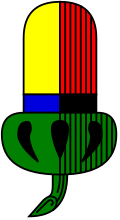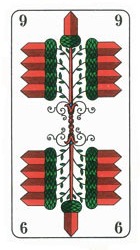| Acorns | |
|---|---|
 Symbol from Bavarian pattern | |
| Native name | German: Eichel |
| Decks | |
| Invented | 15th century |
Acorns ( ![]() ,
, ![]() ) (German : Eichel, or more unusually Hackl or Ecker) is one of the four playing card suits in a deck of German-suited and Swiss-suited playing cards. This suit was invented in 15th-century German-speaking lands and is a survivor from a large pool of experimental suit signs created to replace the Latin suits. Around 1480, French card makers adapted this sign into clubs in a French deck (known as clovers in France). [1]
) (German : Eichel, or more unusually Hackl or Ecker) is one of the four playing card suits in a deck of German-suited and Swiss-suited playing cards. This suit was invented in 15th-century German-speaking lands and is a survivor from a large pool of experimental suit signs created to replace the Latin suits. Around 1480, French card makers adapted this sign into clubs in a French deck (known as clovers in France). [1]
Contents
In English, cards are referred to as in a French deck (e.g. the "10 of Acorns"), but in German as Eichel-Zehn.
Acorns are the highest suit in the games of Skat, Schafkopf and Doppelkopf, but the lowest in Préférence. In Watten, the 7 of Acorns (the Spitz or Soach) is the third highest trump card.
The standard German-suited system of leaves, acorns, hearts, and bells appears in the majority of cards from 1460 onwards. There is no evidence for this system prior to this point. [1]
Acorns appear as one of four suits alongside crowns, bells, and shields in a set of mutilated cards possibly made in Alsace in 1480. [1]
Acorns appear as one of four suits alongside pomegranates [a] , leaves, and flowers in a pack of cards (circa 1523) created by Hans Sebald Beham. The ranks go from 2 through 10 with three court cards: King seated on a horse, Ober, and Unter. Roman numerals are indexed at the top of the cards while Arabic numerals are indexed at the bottom. [3] Notably, all the pip cards have a central stem and there is a sow on the three of acorns; which later would migrate to the deuce when the 3-rank was dropped in later packs.
The standard four Swiss-German suits of shields, acorns, hawkbells, and flowers were found in playing cards inside a book cover (circa 1530) made in Basel. These cards feature the distinguishing banner replacing the 10-rank, and have the three court cards: King seated in a throne, Ober, and Unter. [4] This Swiss-German suit system is believed to have developed earlier with the earliest example dated between 1433 and 1451, though only cards from the shields suit survived. [5]
















